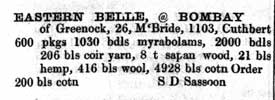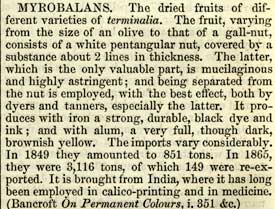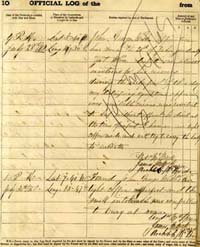To the East Indies: A Young Man's Adventure
In December 1867 Eastern Belle cleared Greenock in Scotland, outward bound for Bombay. Henry Johnson was aboard as an Able Bodied Seaman. Having engaged at £2 15s per month, he was working for the lowest rate of his career. The sum would accumulate over the two years he was with the vessel, but a gap in the record means that we do not know what he was finally paid. A seaman, even a prudent one, could not be free of expenditures on such a lengthy voyage. When the vessel arrived in port, if clothes were sent off the ship to be laundered there would be laundry bills to pay, and every sailor likely had worn-out gear he needed to replace.
At 1103 tons Eastern Belle was a substantial ship. The square-rigged vessel was preferred for these long voyages and profitability depended on large volumes of cargo carried. For a crew of 23 plus 3 apprentices the vessel would be heavy work. Bombay was the destination written on the outer page of the ships' Log Book but when it reached there on 2 June 1868, the Eastern Belle's outward voyage was not complete. A month later it struck out for India's east coast. Arriving at Calcutta in August, it remained there until a cargo was loaded. In October the vessel began its return voyage. The last leg from Bombay to Greenock, took a further five months.


A list of the vessel's dutiable consignments received at Greenock was published in the Customs Bills of Entry. These Bills can still be consulted. In the case of this voyage they reveal that the most substantial part of the Eastern Belle's cargo was raw cotton. One commodity on the list caused Johnson's researchers to wonder. The use to which myrobalans were put was discovered from an entry in a period commercial dictionary. It identified them as a fruit used in dyeing and tanning (McCulloch's Dictionary 1871, 899). Plausibly this cargo and much of what the Eastern Belle had shipped from India was destined for the textile mills in the Glasgow region. It made good business sense for a vessel to be bringing cotton from India at a time when the supply of raw materials from the southern United States was disrupted in the aftermath of the American Civil War. Johnson's own decision to make a lengthy voyage to the East might have been similarly influenced by the upheaval in the North Atlantic. Yet this voyage seems more in keeping with his previous ones. It resonates with a young man's desire to see more of the maritime world in vessels owned and operated from ports in the British Isles.
Many of Johnson's shipmates were young men like himself. Johnson was 24 years old and the average age of all 16 A.B.s on the Eastern Belle is calculated at 24.5 years. Reviewed by birthplace, Scotsmen were the largest group amongst the A.B.s. Together with Irish and English-born hands, they made up the majority of the crew. As a Nova Scotian Johnson was not alone however, two countrymen made them the largest group of colonial seamen aboard. There were German and Scandinavian seamen too.
Over the course of a two-year voyage men would leave the ship and others would join. While dates of discharge and enlisting are entered on the Crew Agreement, the factors influencing crew turn-over are always difficult to pin down. A sequence of incidents recorded in a ship's log prompts speculation that it might not have been a happy ship. Perhaps the Eastern Belle did not start out troubled, but by August 1868 the tensions are clear. With the ship in Calcutta, the Second Mate was demanding more port labor than four crew members were prepared to give (Log book Eastern Belle , 16-18, 1869, MHA). They brought a charge against him for abusive language, and when the magistrate dismissed their case, two of the complainants took matters into their own hands. Ambushing the master and a couple of officers in the street near the Calcutta courthouse, they injured Captain McBride. Two of the assailants were imprisoned for the attack, while the other two were given their discharge from the vessel. The Second Mate stayed, only to take his leave of the Eastern Belle in Bombay. Before leaving Calcutta, the master had to make up the crew complement with six new recruits. On his first attempt he secured two who were discovered to be infected with cholera and who were sent to hospital speedily before the rest of the crew succumbed.
Dysentery Entry, Transcription from the Ship's Captain's Medical Guide
 Sickness and death had already touched the Eastern Belle . Two weeks after leaving Bombay on the outward voyage its youngest member, a 17 year-old apprentice, was diagnosed with dysentery, and soon an A.B., Christian Pederson, had the sickness too. Away from port a ship's master had access only to the official ship's medical guide and the contents of a medicine chest. We have transcribed a description of the symptoms and remedy as they appeared in the Guide. Neither of the Eastern Belle's afflicted crew survived the sickness and its treatment. When the ship's carpenter failed to make an airtight coffin, a plan to have the apprentice's corpse preserved until the ship arrived in port was shelved and the putrefying body was promptly buried at sea.
Sickness and death had already touched the Eastern Belle . Two weeks after leaving Bombay on the outward voyage its youngest member, a 17 year-old apprentice, was diagnosed with dysentery, and soon an A.B., Christian Pederson, had the sickness too. Away from port a ship's master had access only to the official ship's medical guide and the contents of a medicine chest. We have transcribed a description of the symptoms and remedy as they appeared in the Guide. Neither of the Eastern Belle's afflicted crew survived the sickness and its treatment. When the ship's carpenter failed to make an airtight coffin, a plan to have the apprentice's corpse preserved until the ship arrived in port was shelved and the putrefying body was promptly buried at sea.
Clap Entry, Transcription from the Ship's Captain's Medical Guide
This is also the place to mention what was not yet apparent about Johnson's health. A matter of a few months later he had to seek treatment. In Calcutta, Bombay or Greenock, or even aboard the ship, Henry Johnson had a sexual encounter that left him with a dose of what was commonly known as “the clap”. The official medical guide opined the source of venereal disease was “foul women”, or prostitutes, allowing no scope to the possibility of same-sex liaisons amongst an all-male crew. (Leach 1868, 55-56). Johnson's symptoms likely became acute when he was sailing on his next ship. Ironically the name of this barque was the Venus. He was forced to leave before the vessel departed Newport, Nova Scotia in March 1870 in circumstance that were additionally painful since his promotion to bo's'n had happened just five days before. The master of the Venus did not put a name to his illness, so it was not until researchers traced him to the Kewadin that we realized its nature. “Henry Johnson off duty sick with venereal disease had the doctor on board attending him”, Kewadin's master entered in his log (Log book of Kewadin (ON 55990, 1870, 9-10, MHA). Ship owners would not support the costs of treatment for this disease since seafarers were assumed to have brought the affliction on themselves. Johnson found his wages were stopped in reimbursement of the doctor's charges and for the loss of two weeks' work. This immediately preceded the New Orleans voyage on which “More Than a List of Crew” researchers first spotted Johnson and when were left wondering whether our indicative seafarer was not a model seaman as well. A future ship's master he was, but the adventures of youth were provided Henry Johnson by the Eastern Belle .
